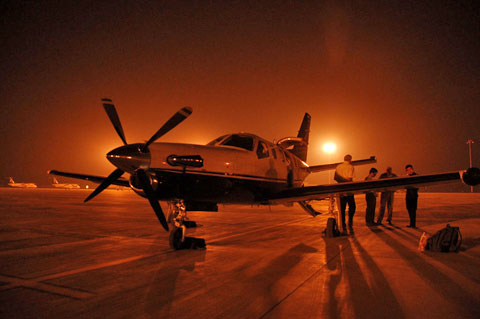
How do you fly your own general aviation aircraft in China? The answer is: It depends. And your mileage may, quite literally, vary. Unlike the well-traveled North American skies, the Chinese airspace has seen very few private GA pilots and aircraft. Each flight is in many ways a special case in the system and handled somewhat differently. A week ago I was lucky enough to be part of such a flight.
Wei Chen plans U.S. stops
As Wei Chen's around-the-world flight nears the end, he will be landing at different areas in the United States. He is scheduled to land at Santa Monica Municipal Airport the afternoon of July 22, where the Friends of Santa Monica Municipal Airport will host a party at the airport's Typhoon Restaurant. Chen also will be flying into Oshkosh, Wis., for EAA Air Venture.
Wei Chen, a Memphis, Tenn., businessman and FAA-certificated private pilot, decided to become the first Chinese citizen to circumnavigate the globe in a GA aircraft. The journey set out from Memphis on May 22 and has ever since been quite an exhilarating adventure for the 40-year-old pilot, his TBM 700, and a few friends who joined him on different legs. After making the eastbound North Atlantic crossing with Wei, I began to prepare for another part of the journey I was invited on, the south/north flight across China with multiple stops.
The permission to fly cross China didn't come easily or a moment too soon. On July 5, two days before Wei’s scheduled departure from Hong Kong, he received the final words that he was cleared to enter the Chinese airspace and was handed the flight plans. It was an exciting moment because he would become the first pilot in the aviation history to fly around the world through China.

An N-numbered single engine airplane has never flown across China before. There is no prior case or ready rules to refer to. We had to make our own case and somehow make it happen. The trail blazing began a few months earlier when Wei and I started calling various friends and companies in the Chinese GA business. Foreign registered GA aircraft are rarely seen in China, with most being large cabin business jets on simple in-and-out flights. On a couple of occasions, teams of aerobatic planes were invited in to perform. To get clearance for what we planned to do, most didn't even know where to start—except for two teams of professionals, AOPA China and GALink Aviation Technology Co. It was a few months of combined tough lobbying efforts and smart navigation through a sea of regulations. At this point common imagination may lead to gray-area deals and paid favors. There was none of that. The major hurdle exists in the current Chinese airspace system, not the people within. If it weren't for the fact that they all had a heart for change and progression, our flight would never have been given the green light.
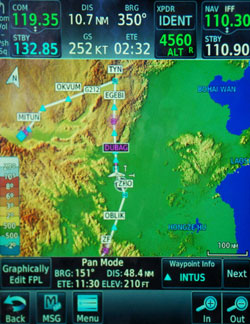 On July 7 Wei took off from Hong Kong and landed in the city of Changsha after a short 1.5 hour flight. Three days later I met up with him to fly shotgun to Xi'An. I had been looking forward to this second-in-command opportunity for some time. Flying chores and the Chinese language are two things with which Wei and I are quite familiar. But when combined they suddenly become an interesting task to look forward to.
On July 7 Wei took off from Hong Kong and landed in the city of Changsha after a short 1.5 hour flight. Three days later I met up with him to fly shotgun to Xi'An. I had been looking forward to this second-in-command opportunity for some time. Flying chores and the Chinese language are two things with which Wei and I are quite familiar. But when combined they suddenly become an interesting task to look forward to.
What is it like to fly in the Chinese ATC system? We were just as clueless as every other U.S. pilot. It was a hot, busy morning with a swirl of continued media interviews. Armed with Jeppesen charts and a thorough briefing—and both dressed like airline pilots—we headed to the airport bus that would take us onto the forbidden territory of a Chinese international airport ramp. There rested the TBM 700, all "Jet A'ed up" and ready. A quick call to delivery yielded the expected clearance, which was a 810-nm route to a destination about 460-nm away. Due to extensive restricted military airspace near Xi'An, we had to fly north to TaiYuan before turning southwest to the destination, a 475-nm detour.
Altitude was measured in meters, atmospheric pressure in milibars, and ATC dictated transition altitudes. All these demanded extra attention. Regardless of the extra work, the climb through SID to cruise was quite smooth. At this point I was quickly adapting to radio transmissions in Chinese. It entails an unfamiliar set of vocabulary and speech characters, but at the same time identical instructional structure, norms, and logic. It was a fair weather day with isolated buildups along the route of flight. 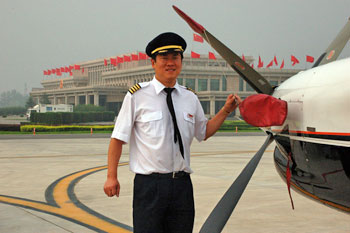 Visibility was reduced by haze from ground all the way up to the flight levels, a weather condition that I would later find common in the rest of our flight in China. Altitude assignments were given in meters. And due to conversion, none of the imperial or metric values are squared off to the thousands. A Chinese airline pilot had sent me a one page "cheat sheet" chart that worked wonders. It was so much easier to refer to than the smaller prints on the Jeppesen charts. Initially we were given 3,600 meters (11,800 feet) and kept there for a while. When asked, ATC told us it was our final altitude. We petitioned for 7,800 meters (25,600 feet) and got up there three or four clearances later. Terrain was vaguely visible through the haze but still an exciting view for the both of us. We were flying a single-engine GA plane in China, the land where we were born and raised. It holds great promises for GA yet still poses difficulties for people to stretch their wings and take flight. Another point of excitement was that we would overfly both the Yangtze and Yellow rivers. They are regarded as the origin of Chinese civilization. The moments came and went quickly, and the rivers were visible through the haze but just a bit too faded for my Nikon SLR camera to focus.
Visibility was reduced by haze from ground all the way up to the flight levels, a weather condition that I would later find common in the rest of our flight in China. Altitude assignments were given in meters. And due to conversion, none of the imperial or metric values are squared off to the thousands. A Chinese airline pilot had sent me a one page "cheat sheet" chart that worked wonders. It was so much easier to refer to than the smaller prints on the Jeppesen charts. Initially we were given 3,600 meters (11,800 feet) and kept there for a while. When asked, ATC told us it was our final altitude. We petitioned for 7,800 meters (25,600 feet) and got up there three or four clearances later. Terrain was vaguely visible through the haze but still an exciting view for the both of us. We were flying a single-engine GA plane in China, the land where we were born and raised. It holds great promises for GA yet still poses difficulties for people to stretch their wings and take flight. Another point of excitement was that we would overfly both the Yangtze and Yellow rivers. They are regarded as the origin of Chinese civilization. The moments came and went quickly, and the rivers were visible through the haze but just a bit too faded for my Nikon SLR camera to focus.
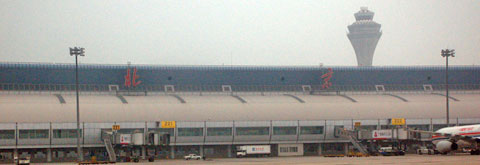
As the flight proceeded, the onboard weather radar painted more and more isolated precipitations. Three or four times we asked for deviations and were cleared to do so immediately. As we approached the XinZheng VOR, Wei and I started to discuss the "great detour." This VOR marks the starting point of the 205-nm leg on a heading of approximately 350 degrees to TaiYuan before a turn to 237 degrees to fly another 270 nm to our destination. An immediate turn to the west at XinZheng would have been non-negotiable because it would put us through the restricted areas.
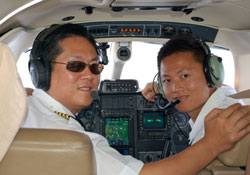 We figured about half way through we could ask to cut across from one way point (PADNO) on the north bound leg to another (OKVUM) on the southwest leg. And so we did. "Continue to TaiYuan." the controller replied with no delay. "Okay" we thought. After all who said that the western style shortcut negotiations would work in China. Heck we should be glad that we could fly at all. But then another transmission (in Chinese) came in through the headset, "N168CW turn left heading 270. Join G212 then direct to OKVUM." There it was, the moment my perception for Chinese ATC based on commonsense guesses and imagination was replaced by firsthand experience. And it was a positive transition. I had thought that the Chinese ATC system must be military like, inflexible with very limited compatibility and tolerances for the way we are used to flying. However my experience proved otherwise. The controllers were very efficient, polite, and quick to the point. What's more they were accommodating and flexible. Chinese airline pilots around us were not at all shy about asking for what they wanted and negotiating. The end result was a safe and efficient traffic flow. I almost felt as if I were flying in the U.S. if it weren't for the language. Speaking of which, English is also used in all but domestic-only terminal areas in China. Transmit in English and you'll get a response in the same. Expect accents but nothing more than what pilots who fly international routes are already accustomed to.
We figured about half way through we could ask to cut across from one way point (PADNO) on the north bound leg to another (OKVUM) on the southwest leg. And so we did. "Continue to TaiYuan." the controller replied with no delay. "Okay" we thought. After all who said that the western style shortcut negotiations would work in China. Heck we should be glad that we could fly at all. But then another transmission (in Chinese) came in through the headset, "N168CW turn left heading 270. Join G212 then direct to OKVUM." There it was, the moment my perception for Chinese ATC based on commonsense guesses and imagination was replaced by firsthand experience. And it was a positive transition. I had thought that the Chinese ATC system must be military like, inflexible with very limited compatibility and tolerances for the way we are used to flying. However my experience proved otherwise. The controllers were very efficient, polite, and quick to the point. What's more they were accommodating and flexible. Chinese airline pilots around us were not at all shy about asking for what they wanted and negotiating. The end result was a safe and efficient traffic flow. I almost felt as if I were flying in the U.S. if it weren't for the language. Speaking of which, English is also used in all but domestic-only terminal areas in China. Transmit in English and you'll get a response in the same. Expect accents but nothing more than what pilots who fly international routes are already accustomed to.

The approach and landing in Xi'An’s XianYang International Airport was fun with spectacular terrain and sightseeing-tour-like vectors. When the runway emerged from the haze, I was quite excited. It was my first landing in China as part of a flight crew. After taxiing off the active we experienced another common "treat" of everyday flying in China, ground delays. We joked that the trip behind the follow-me car burned all the Jet-A we saved from the shortcut. Everyone was asking for estimated departure time on the ground frequency and the answers were uncertain. Maybe it had a lot to do with the prime minister's plane being scheduled to depart shortly after we landed. On the other hand, frequent ground delays are common according to all the Chinese airline pilots I know. It is largely due to the fact so many airports are running close to their maximum capacity. On a prefect day it would work well. But anything such as weather, VIP movements, incidents, etc. can and do trigger chain effects.
Although media personnel were not allowed to enter we still attracted a small group of spectators on the ramp. Like most controllers we spoke to in the air, they knew who we were. My conversation with a 32-year-old Airbus 320 first officer was particularly interesting. Like me he was trained in the United States. With 250 hours in the logbook and an instrument-rated CPL he transitioned into the right seat of an Airbus. Now a few years later he was almost ready to go for the left seat. His pay is a comfortable U.S. $200,000-plus. After learning that I had accumulated 350 hours with all the required licenses he recommended a couple of airlines that I could try. With booming demand for air travel and a pilot shortage, the job market promises high compensation and low entry requirements.

The city of Xi'An and its adjacent areas are particularly energized for general aviation development. Backed by strong local government support, many projects and companies have already come into existence. During our short stay we visited a newly constructed GA airport. It's situated in the middle of a giant "economic development zone," thousands of acres of farm land with a newly constructed, top grade road network. And there it was, a 3,000-foot runway with an ample ramp, a hangar, a few buildings under construction, and 100 school students in uniforms and waves of red banners to welcome the first Chinese citizen flying around the world. A few SR22s and Cessna 172s were doing pattern work. Later I learned that there wasn't much else they could do since the airport, non-existing in any aviation database, was granted a free airspace only 20 kilometers across and 3,000 feet high. There are a few others like it in China. I couldn't help but ask "What can you do with it?" Cross country flights are, for now, out of the question. But everything has to start somewhere. Looking back, this is undoubtedly where low-altitude, piston-engine flying started in China.
The flight to Beijing on July 12 was a short one, but our entire team had come a long way to making it a reality. Beijing Capital International Airport, the now second busiest airport in the world, has never received any single-engine GA airplane, foreign or domestic. There the only GA traffic is super large-cabin business jets, and they are only allowed on off peak schedules and a case-by-case basis. AOPA China pulled off a historical first in getting special permission for us to land in ZBAA. This is a symbolic moment between GA and the center of the Chinese civil aviation. But the moment came a few seconds later than we thought when the "no-sweat" ATIS turned out to be false. Wei's right hand was on the throttle for a missed approach when the approach lighting system came into view at minimum.
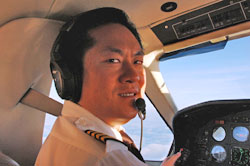 A formal reception at the airport was followed by three days of media interviews and meetings with government delegates and GA professionals and enthusiasts. What a great opportunity for us to speak out in support and promotion of general aviation! And we certainly didn't let it go to waste.
A formal reception at the airport was followed by three days of media interviews and meetings with government delegates and GA professionals and enthusiasts. What a great opportunity for us to speak out in support and promotion of general aviation! And we certainly didn't let it go to waste.
Now as I'm wrapping up the writing at home in New York City, Wei has already landed in Anchorage, Alaska. Soon the first Chinese citizen's around-the-world flight will be completed. It has been an amazing adventure for Wei and everyone involved. This is the mere beginning of our efforts to contribute to China's GA development. And there are a lot more people like AOPA China and Wei who are working hard for the same cause.
Yinjie (Jason) Zhang, a Chinese national residing in New York City, holds an MBA degree from the State University of New York and is an FAA instrument-rated commercial pilot. Zhang was appointed to AOPA China's Board of Directors in 2011. He also writes for several aviation magazines in China and is currently attending Embry Riddle's Master of Aeronautical Science program.
